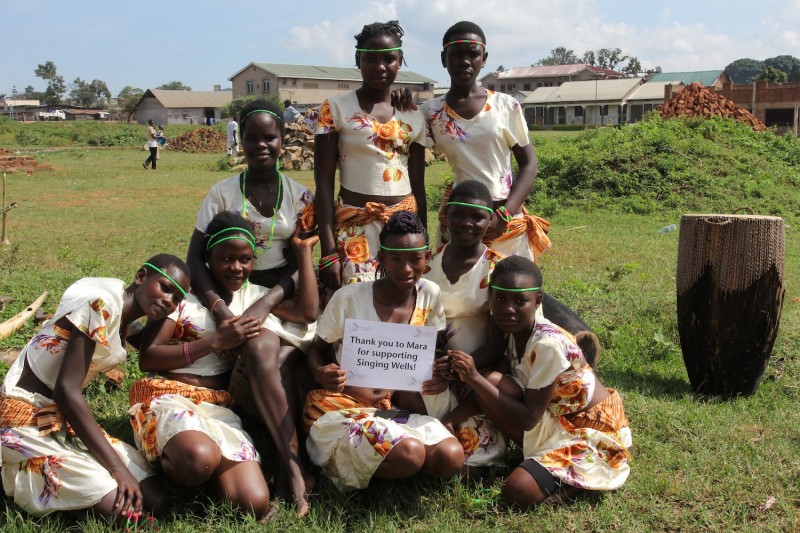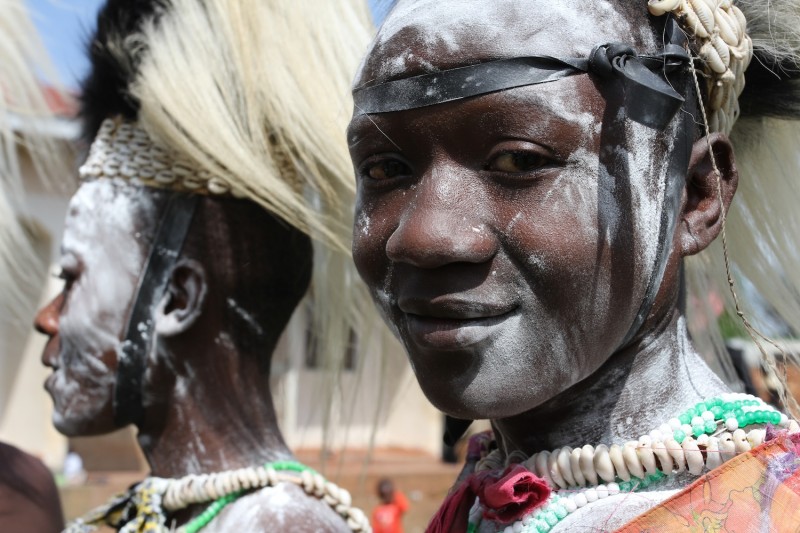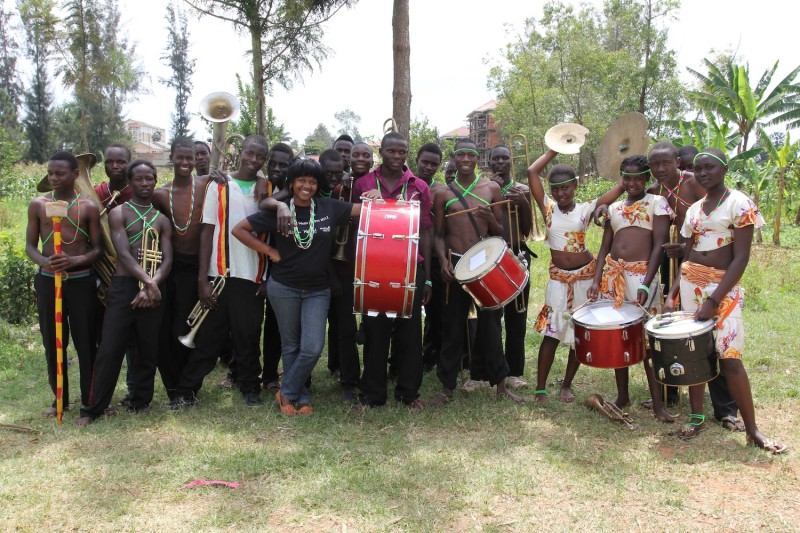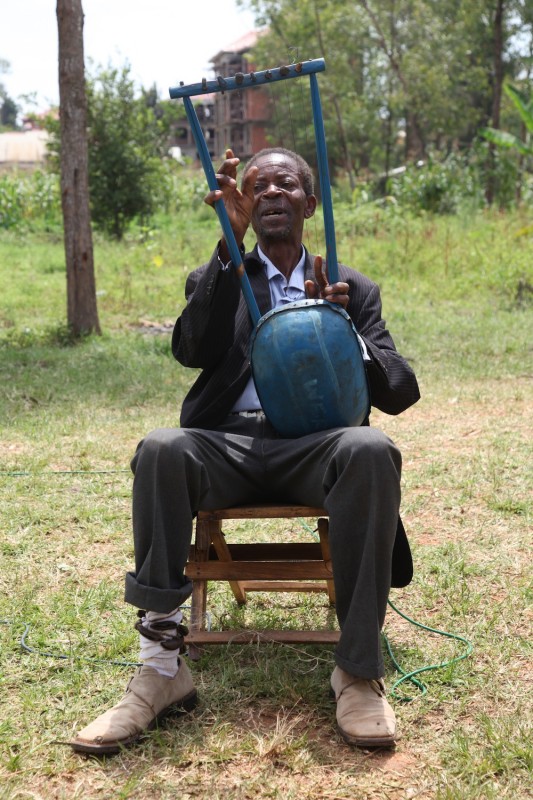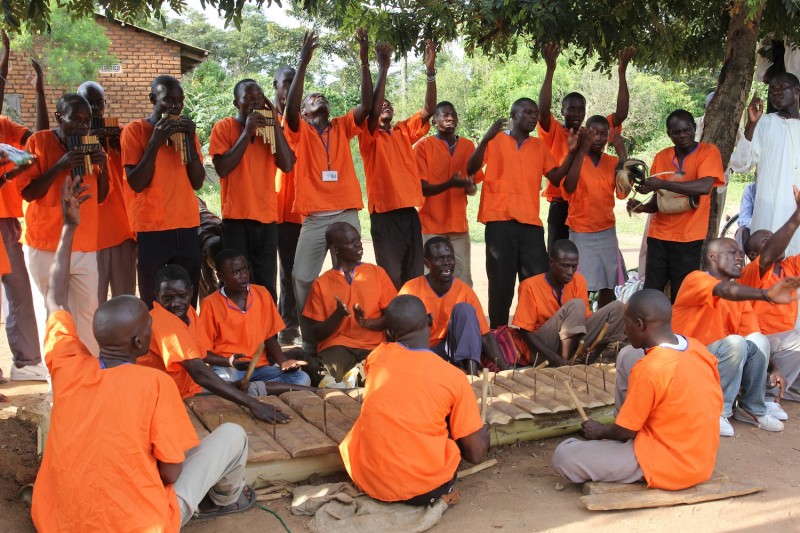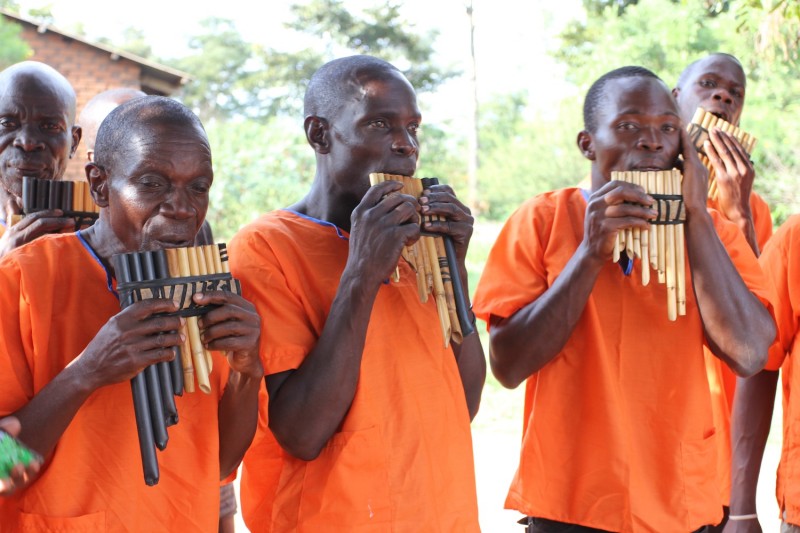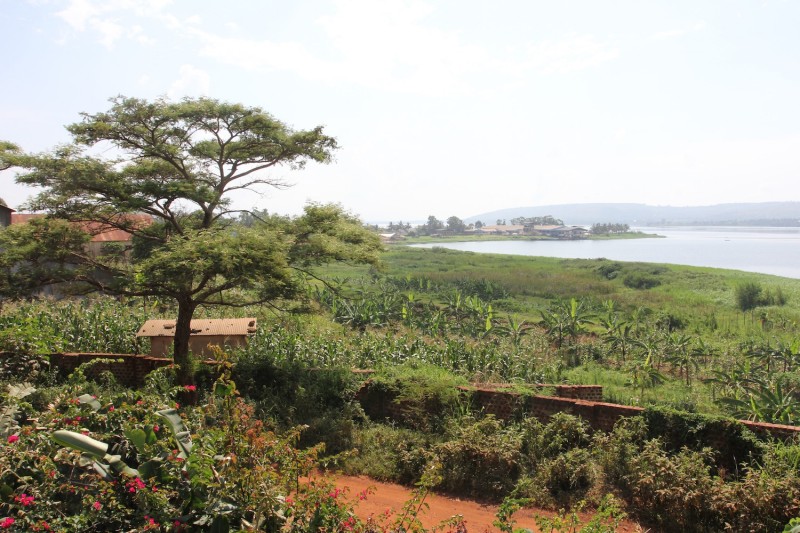The Journey To Site
From the Mt Egon Hotel of Mbale, we drove to the Elgon Ngoma Troupe Centre, a short 20 minute drive.
The Recording Site
We were greeted there by Julius Wolimbwa, the founder of the Elgon Ngoma Troupe. We were recording at his youth centre, which was a fairly large single story building in the middle of a field just off a small road in Mbale. The field was filled with drummers and dancers. The field was also filled with a large tower of red bricks and a separate hill of concrete – clearly there was more construction to follow. We found Julius to interview him and found a quiet place at the back of the building – we had to march across a field of beans and were cautioned not to break the plants as we found a quiet place to talk to Julius. Julius has an amazing story. He was orphaned in 1995 at 9 years old. He struggled through his teens with no support, but found his way gradually as a musical performer, working with the National Theatre and various troupes around Mbale. He was always extremely proud of his tribe, the Bagisu, and always wanted to do something musically building off his own culture. He also wanted to help other kids facing what he faced – either has orphans or from severely disadvantaged homes.
He started to go to University but found that gathering the funds for tuition each time extremely difficult. He had raised the funds for another semester and then asked himself, “Do I want another semester of education, with no promise I will be able to fund another, or can I take this money and start to make a difference?” So he took the money and invested in instruments for children, starting with the Kadodi, the traditional drums of his culture. The Kadodi is made up of a big bass drum, a solo drum played with a stick, a rhythm drum played with hands, a smaller high pitched drum and a shaker.
From two members of his group, they became a band of 12 players. They named themselves the Elgon (the local mountain) Ngoma (generic term for drums) Troupe and starting in 2009 played all sorts of functions that would bring money in to support the band members, all of which live on the premises.
Shortly after, a friend of Julius’s donated some brass instruments and Julius started a brass band, called the Elgon Hero Brass Band. When you combine the two bands, the traditional and the new brass sound, Julius says, they blew audiences’ minds. As the bands have grown there are roughly 160 total members of his group, of which 100 are performers. They are roughly divided between the two bands. For income, they do performances and also work four acres of land to feed themselves. Many of the members also do arts and crafts or a skilled trade – Julius’s dream is to open up a hair and beauty studio so they can support the bride with her beauty and music.
We are here on site to listen to three different groups.
The Elgon Ngoma Troupe
Julius wanted to make sure we opened our morning with him with two major performances from the Elgon Ngoma Troupe, both centered around the tradition of circumcision to mark a boy’s transition from child to man. “In our tradition, if you are 80 years old and have not gone through the ritual of circumcision, you are not a man and cannot sit at the adult table. If you are a two year old and have been circumcised, for us, you are an adult. The two songs we will play for you are the Isonja and the Imbulou. The Isonja is pre-circumcision, a dance to prepare the boys and test the boys to see who is ready. The Kadodi Imbalu Dance is about the ritual itself.”
After we talked to Julius, we assembled in the field where the boys were being prepared for the dance. It was sufficiently hot that the local village kindly set up two tents for us to cover the audio and video engineers. This was most welcome, but our recordings were enhanced once or twice by a gust of wind taking our tents off to strange lands. Nick’s band notes flew as well, and were chased by the village children. One particularly important set of notes was found about half a mile away. But tent and notes recovered and the sessions went on…
They were dressed in beautiful costumes with hats made of monkey skins, a fabric wraparound for their waste, held on with a belt with bells. They also had a ‘tail’ and lovely bead work necklaces. Before the dance, they were ‘powdered,’ so they were covered in fine white dust. They were joined by the drummers and female dancers/singers.
Julius led the group through two songs:
- The Isonja: All massive energy as they boys prepare for the circumcision ritual challenging themselves to bolder and braver physical challenges.
- The Kadodi Imbalu dance: The men of the tribe help prepare/convince the young boy to ensure the ritual. He grows bold and retreats, grows bolder and retreats and then grows bold enough to endure.
After these two songs, Julian took over the lead with his drums and xylophone to play Chiina Chedya Mayi, a beautifully chilled song about the loss of a mother..
Here is their music:
The Elgon Hero Brass Band
Following this very traditional tribal music, the contrast couldn’t be greater – on marched the Elgon Hero Brass Band. Here’s the band with our Influences artist, Jacinta.
They performed the following:
- Malaika (Influences): They started with an Influences Song with Jacinta – they performed the traditional African song, Malaika.
- American Farewell: After this they performed American Farewell (originally called “Wimoweh” and popularised as “A lion sleeps tonight”).
- Altawale. This was a great combination of heavy brass, traditional drums, marching band drums and a good old fashioned American Marching Band Twirler, straight from Music Man.
Here’s their music:
We loved what Julius had created. First and foremost he was giving these kids stability and hope. They were gifted, talented and proud and love to perform. Second, he was building on his culture – he was so proud of his the traditional drums, his tribe and his region and he was giving these kids that pride. Third, he was willing to take all sorts of risks, to make the music fun and modern. If a friend was going to give him old brass instruments, he was going to create a marching band. If he already had a traditional drum band, then he was going to divide the performances with very traditional cultural songs but he’d also add a bit of fusion. Why not?
James Isabirye said the following, “Young people need opportunities to experience what is in and out of Uganda. I don’t think Julius is trying to say the brass band is Ugandan. He is very good at respecting Ugandan traditions but he is also letting the children experience other things. He is opening spaces. By the way, brass bands are very important for certain occasions, like marches. He is providing a great service. Brass music is very good and I love it.” Tabu argued, “He knows the traditions. It is not what you play, but how you play it. He is so steeped in Ugandan music that he will create a very interesting fusion over time.”
Eridat Makwiri, or Muzane
Following the Elgon sessions, we were joined by Eridat Makwiri, a Litungu player. A Litungu is very similar to a Nyatiti, but the musician plays in a chair with the Litungu in his lap. He also has the bells of the Nyatiti player wrapped around his leg, but doesn’t use the toe ring which adds a kick drum when struck against the instrument itself. He is from Manafawa District and playing since 1970 and has played in Kenya, Malawi and Nigeria. He has 7 children none of who want to carry on the music tradition.
Eridat Makwiri was fantastic; a very traditional player who lost himself in his music. Very much a long the lines of the Lou Nyatiti players or Ben Kinsinja. He played three songs:
- Wangoyo: This is a song about co-wives. One lady was lazy. And she would wait for the co-wife who had already woken up and prepared the food. The wife who had prepared the food tried to keep the food away from the lazy wife and the lazy wife would go complaining to the husband. The message in the song is to not wait for everything to be done for you.
- Paolo Wawanyera: This is someone’s name, meaning Paul, son of Wawanyera. Paul was a chief. He visited certain places and found they had made him party with lots of food and drink. He actually visited his brother in law who was jealous of him as a chief. So he decided to poison him.
- Sinairi Mukhana: The person who killed Paul was a Wanyera. He had killed a chief because he was jealous of him. During the burial he pretended to be sad, but the family members of Paul recognized what was going on and organized to murder him. It’s a song about retaliation.
Tabu said of Mazune, “I think he is amazing. He has one of those older traditional voices that is hard to find. I know Robert felt we should invite him to Ugandan festivals. He’s the king in villages, playing at beer parties in villages, invited by the elders in traditional ‘rites of passage.’
Here is his music:
The Journey to the Next Site
We then packed up and said good bye to the Elgon Ngoma Troupe Centre. It was illustrative of their passion that they continue to perform in all corners of the field –they didn’t need cameras or microphones.
We drove 117 kilometers from Mbale to Nakisene (from Mbale south toward Inganga, turning East toward the Kenyan border, just before Buggiri, we turned toward Idudi).
The Recording Site:
The village was far off road, along a dirt path perfectly suited to cows and motorcycles, but slightly more challenging to big vans of the four wheel variety. But, as always, we made it to the location, passing lovely red-mud huts along the way. The village was a large one, probably 7-8 huts surrounding a central area with full size trees. The band had been there since morning preparing and had dug the pit for the xylophone – essentially, they did about 18-24 inches under the bass notes to ensure real depth (and literal depth).
Muwewesi Xylophone Group
The band consisted of about 8 musicians on the xylophone, 5 female singers in beautiful matching outfits, a set of pipe flute players, a tube fiddle players and a men’s choir with alternating lead vocals. Their style is Embaire, which is the xylophone.
Their instruments were:
- Embaire, Xylophone
- Endigidi, tube fiddle
- Enkwanzi, pan pipes
The performance was simply spectacular. Our search for the best xylophone players in Uganda is declared over! What a group.
- Obutasoma (Education), with lead singer Muniru Ayubu
- Obwiire Bukyeire (The Time Has Come), with lead singer Kisubi Eliasa
- Magic Moment: We loved the xylophone and asked the group to replay a minute of Obwiire Bukyeire, with only the xylophone. We asked Vicki to climb in next to the bass notes, so she could get a perfect view of the players.
- Obwavu: This was a song about Poverty
- Nalufuka, followed by dance. This was spectacular with what looked like a dance off between the ‘male dancers’ standing in the back of the band and the xylophone players, urging them on with faster and faster beats. One by one the dancers would jump over the xylophone players to perform in front of them. The players would give the dancers fantastic beats and eventually they would retreat and another dancer would join. All great fun.
James Isabirye says, “This area, where they come from is known for the Xylophone. This particular group has grown out of festivals. They were not as good originally, but the experiences of the festivals, starting in 2005, with Senator (the beer), has really helped them. They have been national champions with them twice and have gotten real support. They now have confidence and skills and an ‘act’ that is great. Their style of music is amazing – they play drumming music on the slabs – they bring the percussion directly on to the instrument. This makes the tone so rich and it is far richer than the skin sound of a drum. The drum sound of the slab, with the hole underneath is actually unique in the world of percussion. They are not limited to 22, because there is no royal role. Anything between 21 and 23 is fine. If they could extend it, they would. The limit is the deeper you go, you can no longer tune the slab. It stops going deeper. The nature of the wood limits the distinct notes to between 21-23. You also saw them dance. They play all the dances they would do with drums with xylophones across the three dance styles of: Tamenhaibuga, Nalufuka, and Irongo.”
Here’s their music:
The Journey Back
After an interesting greeting from the local police we were able to race off toward our hotel, the Gately on the Nile. From the village, we drove back to Jinja via Inganga. We violated our “no night driving” rule for about 40 minutes but we were on very good roads, with very good drivers so no issues. It took a while to find the hotel and we retreated into cabins (Jimmy/Tabu, Steve/Patrick) and individual rooms with the main hotel (Vicki, Nick, Andy). We took showers, met for dinner and as we normally do at this point in our trip, we brainstormed a way to get the performers to join us at the hotel tomorrow. We’ll see!

